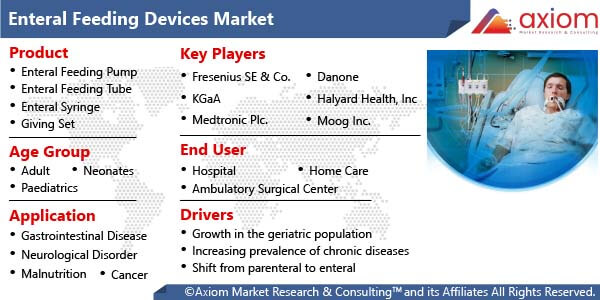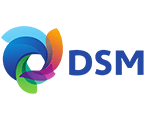Enteral feeding refers to intake of food nutrition taken through the mouth or through a tube that goes directly to the stomach or small intestine. In the medical setting, the term enteral feeding is most often used to mean tube feeding. Enteral feeding is utilised in a condition or injury that prevents a person eating a regular diet by mouth, but their GI tract is still able to function. Thus, being fed through a tube allows patient to receive nutrition and keep their GI tract working. These devices are commonly used to feed the specialized diets in elderly or bedridden patients suffering from chronic ailments, such as neurological disorders, cancer, gastrointestinal and inherited metabolic diseases.
Enteral Feeding Devices Market Outlook
The major driving factors for the growth of the global Enteral Feeding Devices is growing geriatric population. Geriatric population is the largest consumer enteral feeding devices worldwide.
As indicated by the U.S Department Statistics, the number of ageing populace is likely to cross 75 million by 2034 and 93 million by 2060. This statistics highlights the need of growing demand of enteral feeding devices, as this population possesses a high risk and susceptibility of this population group to develop chronic conditions that require enteral feeding.
This risk of chronic disorders increases with age, especially after age 50 and only declines after the age of 80. As all these factors continue to lead the demand of the enteral feeding devices to treat nutrition deficiency associated with the chronic disorders, there is minor impact of economic downturn on the industry. The global enteral devices market doesn’t show any signs of slowing down in 2019. Aging and growing populations, greater prevalence of chronic diseases, and exponential advances continue to increase the demand of the therapeutics .
In addition, increase in the number of preterm births, increasing prevalence of chronic diseases such as diabetes, cancer, gastrointestinal diseases, and neurological disorders coupled with growing awareness of enteral nutrition will also trigger the growth of this market.
Enteral Feeding Devices Market Segmental Overview
The report analyses the global enteral feeding devices market is analysed based on product, age group, and application, end user and geography.
Enteral Feeding Devices Market by Product
The various products of the Enteral Feeding Devices commercially available in the market include enteral feeding tubes, enteral feeding pumps, administration sets, enteral syringes, and consumables. The enteral feeding tube are accessible as enterostomy feeding tube, nasoenteric feeding tube, and oroenteric feeding tube. The enterostomy feeding tube include gastrostomy feeding tube, percutaneous endoscopic jejunostomy (PEJ) tube, and percutaneous radiological gastrostomy and jejunostomy tube. The gastrostomy feeding tubes consist of percutaneous endoscopic gastronomy feeding tube (PEG), balloon gastrostomy tube, and low-profile balloon gastrostomy (buttons). Among aforementioned products, enteral feeding pump has garnered huge interest across various healthcare setting due to its safety and suitable amount of nutrition dispensed.
Enteral Feeding Devices Market by Age Group
The enteral feeding devices are used across populace of various age group including adults (>18 years of age) and pediatrics. The increasing incidence of chronic diseases and disorders resulting in malnutrition and the rapid rise in the aging population.
Enteral Feeding Devices Market by Application
Enternal feeding devices finds major application in gastrointestinal disease, cancer, malnutrition, neurological disorder etc. The cancer segment is further divided into head & neck cancer, gastrointestinal cancer, liver cancer, pancreatic cancer, esophageal cancer, and others. The increasing cancer incidence rate coupled with the increasing number of patients being treated for cancer-induced malnutrition leading to increasing adoption of enternal feeding devices in this application.
Enteral Feeding Devices Market by End User
The major end users of enteral feeding devices include Hospitals, home care settings, and ambulatory care. There is huge demand of enteral feeding devices, particularly enteral pumps in hospitals to manage patient therapy with controlled enteral feeding and medication. It also helps minimize errors.
Enteral Feeding Devices Market by Geography
Geographically, Enteral Feeding Devices Market is studies across North America, Europe, Asia Pacific and Rest of the World. North America accounted for the major market share of the global Enteral Feeding Devices market in 2018. The dominance of the region is attributed to the various factors including presence of a large geriatric population base coupled with the increased incidence of chronic conditions. Growing need for long-term therapy by patients is also propelling the market in this region. Asia Pacific signifies the fastest growing home infusion industry due to growing knowledge of the people on the positive side of home infusion therapy, rising disposable income, and increasing number of chronic diseases and geriatric population in this region.
Enteral Feeding Devices Market Key Players
The major companies operating in this market are Fresenius SE & Co. KGaA, Medtronic Plc., Halyard Health, Inc., Boston Scientific Corporation, Danone, Moog Inc., Braun Melsungen AG, C. R. Bard, Inc., Nestlé S.A., and Abbott Laboratories.
Recent Developments
May 2019: NeoMed unveiled NeoConnect at Home a reusable portfolio of ENFit syringes that do not require a physician’s prescription. The NeoConnect at Home line of ENFit syringes is the first of its kind to be available over the counter (OTC) And FDA 510(k) cleared for reuse
March 2017: Medela LLC has received 510(k) clearance from the U.S. Food and Drug Administration (FDA) to market ENFit Low Dose Tip enteral syringes. When used as intended, the ENFit Low Dose Tip can help to deliver accurate doses while reducing the risk of misconnections. This clearance completes Medela's line of NICU-specific enteral feeding system product.
January 2017: Vygon medical device company, launched easymoov6, an enteral feeding pump. With the help of pump the doctors and nurses can administer and control the flow rate and the amount of food delivered.











